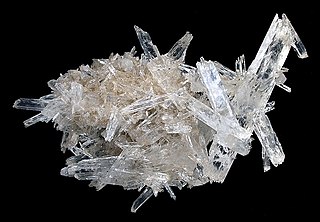
The term Pteridospermatophyta is a polyphyletic group of extinct seed-bearing plants (spermatophytes). The earliest fossil evidence for plants of this type is the genus Elkinsia of the late Devonian age. They flourished particularly during the Carboniferous and Permian periods. Pteridosperms declined during the Mesozoic Era and had mostly disappeared by the end of the Cretaceous Period, though some pteridosperm-like plants seem to have survived into Eocene times, based on fossil finds in Tasmania.
Blairsville is an unincorporated community in Robinson Township, Posey County, in the U.S. state of Indiana.

Macroneuropteris is a genus of Carboniferous seed plants in the order Medullosales. The genus is best known for the species Macroneuropteris scheuchzeri, a medium-size tree that was common throughout the late Carboniferous Euramerica. Three similar species, M. macrophylla, M. britannica and M. subauriculata are also included in the genus.

The Jackfork Sandstone, also referred to as the Jackfork Group, is a geologic formation associated with the Ouachita Fold and Thrust Belt exposed in western Arkansas and southeastern Oklahoma. It is named for Jackfork Mountain in Pittsburg and Pushmataha counties, Oklahoma.



